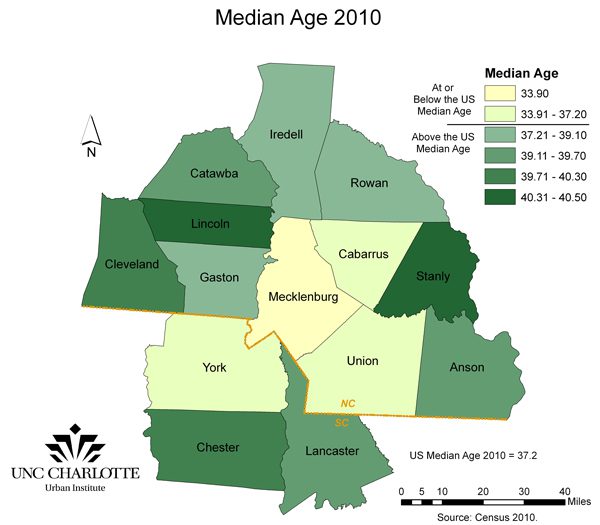Charlotte region ages around a youthful core

In 1960, the median age for the United States was 29.5 years, meaning that half the population was older than that, and half was younger. In the 2010 Census, the median age for the country moved up to 37.2 years, reflecting what many demographers refer to as the “graying of America”. As with other changing demographics, however, this trend is not occurring evenly. Some places are “aging” more quickly than others. In the Charlotte Region, the “youngster” among the 14 counties is Mecklenburg, with a median age of 33.9 years.
As the Baby Boom generation begins to move into retirement years, their large numbers are causing the national median age to increase. In places such as Charlotte and Mecklenburg County, however, which have experienced large population growth and an influx of younger people seeking job opportunities, the median age is often much lower. The map below shows the median age mapped for the counties in the Charlotte Region. The four counties that experienced the strongest population growth in the 2000s also had the lowest median age (Mecklenburg, Cabarrus, Union and York).

Looking across the 14 county Charlotte Region, these four counties were the only ones with median ages at or below the national median age of 37.2 years. In fact, several have reached what is considered the new milestone for the aging of a population, a median age of 40 or more. Chester, Cleveland, Lincoln, and Stanly are all above 40 in median age. To provide context, as of 2010, only seven states have hit this milestone: Maine, Vermont, West Virginia, New Hampshire, Florida, Connecticut and Pennsylvania. By comparison, the Carolinas have median ages of 37.9 (SC) and 37.4 (NC).
The table below shows the 2010 median age of counties in the Charlotte Region in order from youngest to oldest, as well as their change in age since the 2000 census. Some interesting patterns emerge. For example, Union and York counties experienced some of the strongest population growth in the Carolinas during the 2000s; yet, their median age increased from 2000 at rates higher than those of either Mecklenburg or Cabarrus counties, the region’s other hyper-growth counties. This demonstrates the diverse nature of the Charlotte region’s growth, with a relatively young population being attracted to Mecklenburg and Cabarrus counties, and a slightly older population to Union and York. And while the region’s core remains younger than the national median age, its outlying counties have grown increasingly older. In fact, only Mecklenburg and Cabarrus saw their median age increase at a rate below the national rate from 2000 to 2010.
 These recent patterns of migration and population growth have created noticeable differences in the age profiles of counties within the Charlotte Region. For example, the difference in median age between Mecklenburg and Stanly (1st and 14th on the list) was 3.8 years in 2000. By 2010, that difference had grown to 6.6 years. These differing age profiles are important for policy makers, as issues such as planning for future school populations, ensuring adequate and affordable housing options for seniors, and providing health care are all affected by these trends. Further, the relationship between economic growth and the age of a community’s population suggests that those counties faced with meeting the growing service needs of an aging population may be the ones least prepared to do so financially.
These recent patterns of migration and population growth have created noticeable differences in the age profiles of counties within the Charlotte Region. For example, the difference in median age between Mecklenburg and Stanly (1st and 14th on the list) was 3.8 years in 2000. By 2010, that difference had grown to 6.6 years. These differing age profiles are important for policy makers, as issues such as planning for future school populations, ensuring adequate and affordable housing options for seniors, and providing health care are all affected by these trends. Further, the relationship between economic growth and the age of a community’s population suggests that those counties faced with meeting the growing service needs of an aging population may be the ones least prepared to do so financially.
Photograph by Nancy Pierce
Read related articles about the changing demographics of the Charlotte Region.
Read a report on the national trends on age from the Census Bureau.